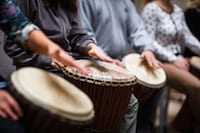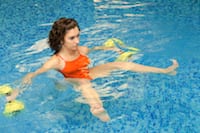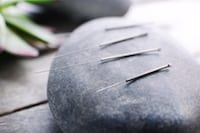How can alternative therapy help?
For many children and adults with cerebral palsy, therapy programs are an essential part of managing symptoms and improving overall mobility.
Doctors and specialists will often recommend starting with traditional CP therapy options, such as physical, occupational and speech therapy. These therapies generally allow for improved mobility, speech and overall independence.
However, each case of cerebral palsy is different. For this reason, your child’s therapy and treatment plan should be based on their individual symptoms and mobility limitations. Those with more severe types of CP or coexisting conditions may respond better to complementary or alternative types of therapy.
The medical term “Complementary and Alternative Therapy” describes a set of treatment methods that are not presently considered to be traditional CP treatment (i.e., physical, occupational, and speech therapy).
The term “complementary therapy” refers to therapy that is used in addition to conventional therapy. “Alternative therapy” refers to therapy that replaces conventional CP therapy.
Complementary and alternative therapy options for CP include:
- Hippotherapy
- Music therapy
- Aquatic therapy
- Acupuncture
There are a number of benefits that stem from alternate treatment methods. Your doctor may recommend adding an alternative therapy program to your child’s existing treatment plan, or they may suggest utilizing another treatment method entirely. A CP specialist will be able to recommend the best therapy options available based on your child’s diagnosis, performance, and progress.
Hippotherapy

Hippotherapy is a form of therapy used to improve muscle tone and mobility. Contrary to its name, this therapy doesn’t require any hippos, but rather – horses.
Hippotherapy involves horseback riding and channeling a horse’s natural movement to improve mobility and posture over time. Hippotherapy is also referred to as “equine therapy.”
Horses exert patterns of movement and rhythm as they trot, which forces the rider’s torso and hips to mimic this movement in order to stay mounted on the horse. In turn, this allows the joints, muscles, and bones to become properly aligned.
Working consistently to improve an individual’s natural motor responses over a series of therapy sessions can help overall movement while off-horse.
Benefits of hippotherapy for cerebral palsy
There are a number of positive results that can stem from utilizing hippotherapy for CP treatment. Hippotherapy can be used to improve:
- Abnormal muscle tone
- Impaired coordination
- Decreased mobility
- Poor posture
- Impaired balance
- Impaired limbic system function (trouble processing emotions and memories)
In a study performed on hippotherapy in 2002, 17 children with CP were asked to ride for 1 hour per week for 18 weeks. It was concluded that all children exhibited improvement, specifically in the walking, running, and jumping portions. It was also noted that these improvements lasted at least 16 weeks after the therapy was completed.
In addition to the physical benefits of hippotherapy, there are also many ways that this therapy can be used to enhance mental health and communication. Horses are thought to be physically, psychologically, and emotionally comforting animals.
There is a bond that often develops between a rider and a horse. This can provide an important source of motivation, confidence and encouragement for an individual with CP.
Music therapy
 Common symptoms of cerebral palsy are issues related to cognitive functioning, speech and motor skills. Music therapy can be used to enhance these areas and allow for improved functioning overall.
Common symptoms of cerebral palsy are issues related to cognitive functioning, speech and motor skills. Music therapy can be used to enhance these areas and allow for improved functioning overall.
According to the American Music Therapy Association (AMTA), music therapy is defined as the emerging, evidence-based use of sound and rhythm to establish a therapeutic relationship between an individual and their therapist.
Benefits of music therapy for cerebral palsy
Music therapy utilizes an array of exercises to improve an individual’s CP symptoms. Music therapy can improve:
- Motor skills (dancing, walking, stomping, arm movement; shaking or moving musical instruments)
- Coordination (shifting weight side to side with body movements to music)
- Communication skills (expressing feelings and emotions in new ways)
- Language processing (matching sounds to an expected movement or dance)
- Auditory responses (hearing and responding to music cues)
- Relaxation
- Range of motion
Music is an effective platform for managing many of the symptoms of CP. During music therapy, children work with a music therapist to complete an array of fun, interactive activities. These often encompass singing, playing instruments, dancing to the beat, composing songs, and listening to certain sounds or words.
Music therapy is closely related to enhanced cognitive functioning. Research has shown that it can increase alertness because the beat of the music helps the brain form meaningful neuroconnections related to concentration and focus. This helps individuals with CP function better with and without music present.
Aquatic therapy

For children with severe types of CP or mobility limitations, aquatic therapy can be a very beneficial option. When compared to traditional physical therapy, water-based exercise offers a fun, less intimidating alternative.
Aquatic therapy entails performing a series of exercises while in the water, such as length swimming, shallow-water tuck jumps, stride jumps, jumping jacks, and wall-and-sit kicking.
When immersed in water, individuals with CP will be able to perform an array of exercises that may not be possible on land, such as jumping jacks. This is due to the way that water reduces pressure on muscles, bones and joints — allowing for free movement.
Benefits of aquatic therapy for cerebral palsy
There are a number of physical and cognitive benefits that can come from aquatic therapy. This type of therapy can be used to improve:
- Flexibility
- Respiratory function
- Muscle strength
- Gait
- Coordination
- Endurance
Over the years, there has been much research conducted regarding the advantages of using aquatic therapy for CP treatment. One study published in 2007 set out to examine the effects of water therapy on individuals with limited mobility.
Researchers studied the way that 37 children with delayed mobility reacted to different types of therapy. Half of the children were prescribed water therapy, while the others were prescribed traditional physical therapy on land. The study concluded that the water therapy group exhibited improved balance, weakness and mobility when compared to those who received traditional physical therapy.
Acupuncture

Cerebral palsy is often associated with back pain, joint inflammation, muscle weakness, and neck pain. In order to reduce this pain and discomfort, many children and adults with cerebral palsy have turned to acupuncture.
Acupuncture is a form of complementary therapy. This means that when used in addition to traditional therapy sessions, acupuncture can significantly improve neurological functioning and muscle hypertonicity.
Acupuncture originated in China, where it has been used to prevent and treat diseases for thousands of years. Acupuncture treatment is typically given 2 to 3 times a week for about 10 total sessions.
This therapy involves the insertion of fine needles into the body at specific entry points. When used for CP treatment, acupuncture needles will generally be placed in defined areas on the scalp, ears, fingers, arms, legs, and feet.
Benefits of acupuncture for cerebral palsy
While acupuncture has long been recognized as an effective treatment method by the Chinese, it has only gained popularity in the U.S. over the last 40 years. Acupuncture can be used to improve:
- Weakness of legs, arms and hands
- Loss of speech (aphasia)
- Loss of voluntary movement (ataxia)
- Loss of hearing
- Pain caused by the central nervous system
- Balance and coordination
In a study from 2012, it was found that acupuncture can improve or remove some symptoms of CP in children. Michael, a 6-year-old patient with CP, was the subject of the study and was treated using acupuncture for 15 total sessions.
Before acupuncture, Michael’s parents reported that he had never spoken a full sentence and had almost no coordination in his upper or lower limbs — despite several years of traditional therapy. By the end of the study, Michael was able to speak in full sentences and voluntarily move his body and limbs, and his math and reading scores progressed by a grade level.
While Michael’s experience with acupuncture displays an important medical advancement for alternative CP treatment options, this type of therapy should only be used when recommended by your child’s doctor. Additionally, it is important to note that acupuncture is a complementary therapy and should be used in addition to traditional therapies.
Finding hope in alternative CP therapy
For parents and their children, it can be incredibly frustrating to undergo extensive, exhaustive, and costly CP therapy — only to find that your child’s condition doesn’t seem to be improving.
Fortunately, alternative therapy is paving the way for CP treatment that is focused on the individual and their overall limitations rather than what has been used in the past. No two cases of cerebral palsy are the same, and your child’s therapy method should reflect this.
The first place that parents should begin their search for alternative CP therapy is with your child’s doctor or cerebral palsy specialist. These medical professionals have first-hand experience with your child, their symptoms and which areas could be improved. They will likely recommend a type of alternative therapy they feel is best, or even a specific therapy center in your area.
For more information on alternative therapy for CP, try downloading our free Cerebral Palsy Guide here.


